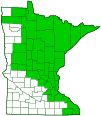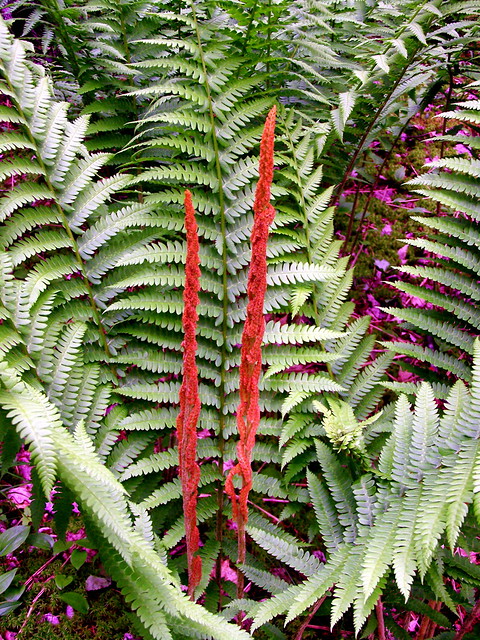cinnamon fern
(Osmundastrum cinnamomeum)
Conservation • Wetland • Description • Habitat • Ecology • Use • Distribution • Taxonomy
Description |
||
Cinnamon fern has conspicuously clumped sterile fronds up to 60″ long. In Minnesota they are unlikely to reach more than 36″ long at maturity. They are slightly tapered at the base. The lowest pinnae are more than half as long as the longest one. On the undersurface of the leaf there is a small area of woolly, cinnamon-colored hairs at the base of the pinnae. Fertile fronds are much shorter and rigidly erect. They are green when they emerge and turn cinnamon-colored when they mature. After spore dispersal they fall to the ground and become inconspicuous, making identification more difficult. |
||
Height |
||
12″ to 36″ |
||
Similar Species |
||
Interrupted fern (Claytosmunda claytoniana) fertile fronds are silimar to sterile ones but taller, more erect, and with brown fertile fronds in the middle of the blade that fall off early in the season leaving a gap. The sterile pinnae do not have a tuft of hairs at the base. |
||
Habitat |
||
Moist. Swamps, streambanks. Full shade. |
||
Ecology |
||
Sporulation |
||
Spring to early summer |
||
Pests and Diseases |
||
|
||
Use |
||
|
||
Distribution |
||||
|
Sources |
|||
| 3/23/2023 | ||||
Nativity |
||||
Native |
||||
Occurrence |
||||
|
||||
Taxonomy |
|||
| Kingdom | Plantae (Plants) | ||
| Division | Tracheophyta (Vascular Plants) | ||
| Subdivision | Polypodiophytina | ||
| Class | Polypodiopsida (ferns) | ||
| Subclass | Polypodiidae (leptosporangiate ferns) | ||
Order |
Osmundales | ||
Family |
Osmundaceae (royal fern) | ||
Genus |
Osmundastrum (cinnamon ferns) | ||
Unitl recently, this species was classified as Osmunda cinnamomea. Based on a genetic and morphological study published in 2008 it was placed in its own genus Osmundastrum. Cinnamon fern is now the only species in the new genus Osmundastrum. |
|||
Subordinate Taxa |
|||
|
|||
Synonyms |
|||
Osmunda cinnamomea Osmundastrum cinnamomeum |
|||
Common Names |
|||
buckhorn cinnamon fern |
|||
Glossary
Pinna
One of the primary divisions of a pinnatifid leaf.
Pinnatifid
Deeply cut, more than half way to the midrib but not to the midrib, into lobes that are spaced out along the midrib; the lobes do not form separate leaflets.
Visitor Photos |
|||||
Share your photo of this plant. |
|||||
| This button not working for you? Simply email us at info@MinnesotaSeasons.com. Attach one or more photos and, if you like, a caption. |
|||||
Luciearl |
|||||
Cinnamon fern-grows in a wetland near the walking trail in Lake Shore |
|||||
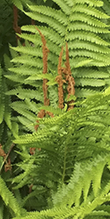 |
|||||
MinnesotaSeasons.com Photos |
|||||
Plant |
|||||
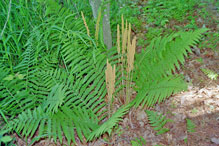 |
|||||
Sterile Frond |
|||||
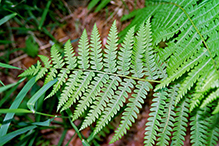 |
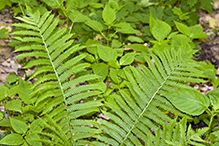 |
||||
Fertile Frond |
|||||
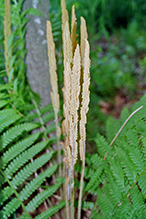 |
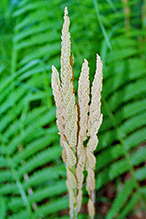 |
||||
Pinnae |
|||||
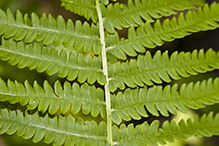 |
|||||

Visitor Videos |
|||
Share your video of this plant. |
|||
| This button not working for you? Simply email us at info@MinnesotaSeasons.com. Attach a video, a YouTube link, or a cloud storage link. |
|||
Other Videos |
|||
| Woodland Ferns - Joey Williamson clemsonpsa |
|||
About
Uploaded on Jun 9, 2009 I'm Joey Williamson, and I'm a horticulturist with the Clemson Home & Garden Information Center. Today we will be looking at some woodland ferns that are easy to grow. There are many beautiful ferns that are popping up now, & some that are in full bloom. The first one I would like to show you is the cinnamon fern (Osmunda cinnamomea). The cinnamon fern has these fertile fronds that come up bearing its spores, which is rather unique for a fern. Most ferns will make their spores (and they spread by spores, not seeds), with the spores in little packages on the backside of the leaves. But in this species of fern, they have sterile fronds and fertile fronds. There are cinnamon colored hairs on these fertile fronds that give it the look of a big tall cinnamon stick. These ferns would like to have moist soils, and often they grow near stream banks, or bogs, or in a wet area near a lake. They can tolerate some sun if they are given adequate water. Usually they like rich, moist, well-drained soils, with adequate water to keep them growing and prevent the fronds from dying back. The cinnamon fern is a very handsome fern. It does lose its leaves with the first frost, so it is a deciduous fern. It is one of our bigger and better native ferns, and an excellent addition for your garden. The fern we are visiting now is the northern maidenhair fern (Adiantum pedatum). This is a delicate-leafed fern that does spread by underground stems called rhizomes. So by putting in a few plants, eventually they will cover many square feet as long as the soil is moist and well drained. The best way to plant this fern is to make sure you improve the soil in the bed using your own compost or composted pine bark to loosen up the heavy clay soils. The key to having good plant growth is by having healthy soil. The plants do need to stay moist during the summer, because if they become too dry, the little leaves will begin to burn and senesce and wont look as good toward the end of summer. This is a wonderful addition to the garden. It grows best in mostly shade to partial shade. Its a great plant. The last fern we will visit today is the autumn fern (Dryopteris erythosora). This fern starts out its growth as young fiddle heads that are very coppery-red colored and slowly expand. These come from a particular genus of plants that is indigenous to Asia, so they are not natives here. This fern comes from a very tough and adaptable genus of plants, and these ferns are some of the most drought tolerant plants I have ever seen. Lets move on to see some that are a little more advanced. On this autumn fern the fronds have become taller, and they have almost totally unfurled. We can still see much of the coppery-red color on the foliage, and this combines extremely well with many of the green companion plants that can be planted around it. Here we have a more fully mature plant showing its splendor and height. These are absolutely gorgeous plants, and as I said they are very drought tolerant. You do want to really improve the soil when you plant ferns. Make it a rich soil. Use your own compost. If you dont have a compost pile, buy composted pine bark to mix with the soil. Keep them well watered until they are established, and they should do absolutely wonderful in your yard. For more information on gardening, landscaping, insect and disease problems on your plants, visit the Home & Garden Information Center web site at www.clemson.edu/hgic. |
|||

Visitor Sightings |
|||||
Report a sighting of this plant. |
|||||
| This button not working for you? Simply email us at info@MinnesotaSeasons.com. Be sure to include a location. |
|||||
| Luciearl June 2023 |
Location: Lake Shore Cinnamon fern-grows in a wetland near the walking trail in Lake Shore |
 |
|||
MinnesotaSeasons.com Sightings |
|||||

|
Created: Last Updated: © MinnesotaSeasons.com. All rights reserved. |
